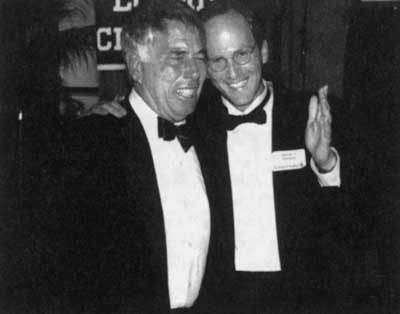
This Article From Issue
January-February 2010
Volume 98, Number 1
Page 85
DOI: 10.1511/2010.82.85
THE CALCULUS OF FRIENDSHIP: What a Teacher and a Student Learned about Life While Corresponding about Math. Steven Strogatz. xiv + 166 pp. Princeton University Press, 2009. $19.95.
Take a minute to think back a few years—okay, maybe a few more than that—to your high school days. Think past the awkward dances, the tortured relationships, the overhyped football games, to your high school math teachers. Who were they? What were their lives like? What did they do when they weren’t teaching you how to factor, what a logarithm is or how to take derivatives? What are they up to now?
Unlike many of us, Steven Strogatz can actually answer these questions, at least with regard to his high school calculus teacher, Don “Joff” Joffray. Strogatz shares those answers and much more in The Calculus of Friendship. Part biography, part autobiography and part off-the-beaten-path guide to calculus, this quick read details 30 years of correspondence between Strogatz (who is now Jacob Gould Schurman Professor of Applied Mathematics at Cornell University) and Joffray.
Calculus, Isaac Newton’s ingenious invention for modeling change mathematically, serves as both text and subtext for the letters that pass between Strogatz and Joff. Focusing almost exclusively on questions of mathematics, these brief notes frame the unlikely friendship of a teacher and his star student. With the precision of an award-winning mathematician and the clarity of a best-selling science author, Strogatz leads us on an excursion through some of the lesser-known mathematical sights—the ones usually reserved for the “members only” tour. All the while, we see the relationship between the two men gradually change as they slowly (and I do mean slowly) break down the walls that appropriately separate teacher from student.
The mathematics covered in these letters is impressive for such a short volume—and for an exchange with a high school math teacher. The two men discuss pursuit problems. For instance, a dog starting at (0,1) in the x,y plane chases a man running at the same speed along the x-axis, with the dog swerving in such a way that it is always running straight toward the man’s current location. What is the equation for the curve traced by the dog’s path? Strogatz regales Joff with a geometrical proof that the square root of 2 is irrational. He recalls Joff telling the class about a former student finding a formula for the nth term of the Fibonacci sequence (which begins 1,1,2,3,5,8,13, ... ):

Then Strogatz provides a succinct two-page proof. One of Joff’s later students asks whether the series

converges, leading to a discussion of Fourier series (and the surprising sum of the series).
Although the pair’s mathematical excursions pay off every two or three pages, the story of their relationship takes longer to develop. Five chapters into the book, you may feel like responding to the book’s subtitle—What a Teacher and a Student Learned about Life While Corresponding about Math—with a resounding “Nothing!” Only Strogatz’s criticisms of the younger, more self-absorbed version of himself keep this strand of the story alive, as when he admits the shame of never having acknowledged the death of Joff’s oldest son.

From The Calculus of Friendship.
Over the years, their correspondence begins to include news of their lives along with the interesting mathematical tidbits. This broadening of their relationship comes just in time—another cold mathematical exchange might have convinced us that mathematicians hail not from Mars or Venus but from Pluto. In the last few chapters, the two men write (and in some cases talk) about Strogatz’s career path, Martin Gardner’s mountain-climbing-monk problem, Joff’s windsurfing, a clever use of dimensional analysis, Joff’s teaching award, and where to put the fuel gauge marks for a cylindrical gas tank. The growing affinity of these two for each other as people, and not just as sources of mathematical knowledge, provides a more interesting frame for the still-captivating mathematical excursions.
Eventually Strogatz works up the nerve to travel to Joff’s home to discuss some of the personal things their letters glossed over. An account of the visit brings the book to a satisfying, if slightly sappy, conclusion. Finally the author’s nonmathematical observations rise to the level of his mathematical ones, as in this wonderful passage about the complicated relationship between a teacher and a gifted student:
I’m starting to realize what it was that he gave me.
He let me teach him.
Before I had any students, he was my student.
Somehow he knew that’s what I needed most. And he let me, and encouraged me, and helped me. Like all great teachers do.
As every educator knows, in the relationship between teacher and student, the learning happens in both directions.
David T. Kung is associate professor and chair of the department of mathematics and computer science at St. Mary’s College of Maryland. His interests include harmonic analysis, math education and the violin.
American Scientist Comments and Discussion
To discuss our articles or comment on them, please share them and tag American Scientist on social media platforms. Here are links to our profiles on Twitter, Facebook, and LinkedIn.
If we re-share your post, we will moderate comments/discussion following our comments policy.